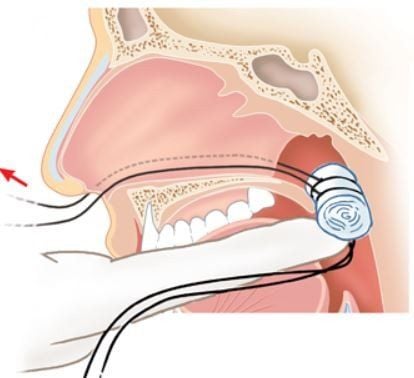This is an automatically translated article.
The article was consulted with Specialist Doctor Ear - Nose - Throat Doctor - Department of Medical Examination & Internal Medicine - Vinmec Hai Phong International Hospital.
Nosebleeds can be classified into 3 main types based on the source of bleeding, including Kisselbach pulse point, arterial bleeding and disseminated capillary bleeding. If bleeding is in the posterior and upper nasal cavities, then the posterior nasal wick should be inserted to manage the bleeding. If the condition is not resolved, surgical intervention is required to stop the bleeding.
1. Anatomy of the posterior nasal blood system
Characteristics of the nasal mucosa include the respiratory mucosa. They have the function of warming and increasing the humidity of the air when inhaled thanks to a dense capillary system. These capillaries are located very shallowly, so even the slightest trauma can cause a nosebleed. Sometimes the nosebleed is very violent due to the rupture of large artery branches. This condition can be life-threatening if not treated promptly.
The anatomy of the nasal vessels originates from the external carotid artery, which includes branches such as the spheno-palatal artery and the ascending palatal artery. Another source from the internal carotid artery includes the branches of the anterior ethmoid and posterior ethmoid arteries.
Arterial branches will merge at a point anterior inferior to the nasal septum and about 1.5 cm from the opening of the nostrils, also known as the kisselbach pulse point. The capillaries of this vascular system run very shallowly, so they are vulnerable to physical impacts such as nose picking, trauma...
2. Causes of posterior nosebleed
Causes of posterior nosebleeds can be surgical or medical. In terms of surgery, trauma is the main cause such as stab wounds, work accidents, traffic accidents. Medical causes can be due to chronic diseases such as high blood pressure or blood diseases such as acute myeloid leukemia, marrow failure or hemophilia, liver failure, chronic kidney failure, infectious diseases such as dengue fever. blood.
Bleeding can be classified into 3 main categories based on the source of bleeding, including Kisselbach pulse point, arterial bleeding and disseminated capillary bleeding. Bleeding from the capillaries is characterized by oozing throughout the nasal mucosa and usually has no definite bleeding point, which is common in acute myeloid leukemia, hemophilia, dengue fever, and typhoid.

3. Clinical symptoms of posterior nosebleed
3.1 Light bleeding Causes may be due to minor trauma due to the habit of picking your nose, diseases such as flu, typhoid. Or sometimes there is no obvious cause in otherwise healthy people.
Nasal examination can show bleeding coming from a pulse point or an artery. The amount of bleeding is not much, only drops and tends to stop on its own. The disease can recur many times. This type of nosebleed is common in children and the prognosis is mild.
3.2. Heavy bleeding is usually caused by rupture of the nasal arteries in conditions such as high blood pressure, atherosclerosis, or cirrhosis of the liver. Subjects are elderly patients with pre-existing chronic diseases. In the case of trauma usually due to damage to the ethmoid artery.
Nasal examination is often difficult to see the flow point because of its high and posterior position.
4. Indications for stuffing nose wicks after nosebleed treatment
When a patient is having a nosebleed, the first treatment is to stop the bleeding and then find the cause.
If the bleeding is coming from a pulse point or branches of the sphenoid artery, you can squeeze the nostrils with your fingers, so that the bleeding point from the kisselback is squashed. It is also possible to use a wick impregnated with vasoconstrictor drugs such as ephedrine or antipyrin 20% to conduct tight insertion into the nasal cavity and vestibule. Silver nitrate or electric cote combustion can also be used.
Nasal wicking after the treatment of nosebleeds is usually indicated because of lesions behind and above the nasal cavity or the patient has had a nasal wick before but it is not effective.
In addition to the tools used for placing the anterior wick, an additional Nelaton tube is required, a cylindrical gauze about 3cm long tied to a strong thread 25cm long, the second gauze is also cylindrical but about 1cm in diameter.

Steps to perform the following nasal wick insertion include:
Place the Nelaton tube into the bleeding nostril and then push the tube down the throat. Ask the patient to open their mouth and use forceps to remove the tip of the Nelaton catheter from the mouth. Tie one end of the gauze thread to the end of the Nelatonic tube. Pull the Nelaton tube back from the throat to the nose. The gauze will be pulled back from the pharynx to the nasopharynx and tightly closed to the posterior nasal cavity. When the gauze goes through the waist, the pharynx will often be entangled, the doctor should use the index finger of the right hand to gently push the gauze up and behind to help the gauze pass through the narrow waist. The left hand will hold the Nelaton tube and the thread will be pulled slightly forward. Finally, remove the thread from the tube and tie it to the second gauze, which closes the anterior nostril. Once the rear wick is inserted, the front wick can be added if necessary. Other accompanying treatment:
Perfusion, blood transfusion Drugs to support hemostasis such as vitamin C, CaCl2, vitamin K, transamin, hemocaprol. Drugs acting on the cardiovascular system such as Spartein, ouabain Strong broad-spectrum antibiotics such as third-generation cephalosporins. Pain relievers profenid, efferalgan-codein, alaxan. Sedative group: seduxen, stilnox, rotunda, gardenal. However, in cases where the posterior and anterior nasal wicks are inserted but the bleeding cannot be stopped, the internal maxillary artery can be tied at the position of the sphenoid fossa or surgical ligation of the anterior ethmoid artery and the posterior ethmoid artery is located at the sphenoid fossa. the inner margin of the eye socket.
Please dial HOTLINE for more information or register for an appointment HERE. Download MyVinmec app to make appointments faster and to manage your bookings easily.








